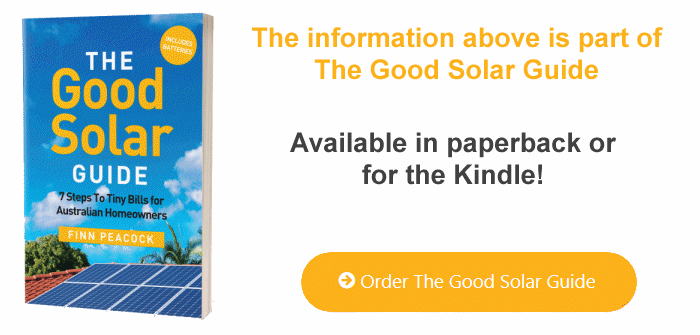The different approaches to buying solar
← Solar Power System Sizing | The Good Solar Guide Contents | Solar Financial Returns →
Let’s be honest: if you have a grid connection, you don’t need solar power. Having solar panels on your roof doesn’t add any features to your home. The electricity from the panels doesn’t run your appliances any better than grid electricity does.
Why do people buy solar? They do it for these three reasons:
- Financial: to reduce their bills and save money.
- Ethical: to take responsibility for the energy that their home uses, and to generate some or all of it virtually carbon-free7.
- Material: Solar panels are cool, and you just want them!
If your motives are purely financial, it’s important that you understand the economics of your investment in solar power. This will allow you to make an economically rational decision about whether you should spend thousands of dollars on a money-saving device.
If your motives are purely ethical, good on ya! You think that if carbon-free generation can be added to a home for a reasonable cost, you have a moral responsibility to install it and reduce the load on the predominantly coal-fired grid from your home. You’re probably even pretty relaxed about exporting your ‘spare’ solar back to the grid for a low price, because your exported solar electricity is reducing the impact of your neighbours’ energy choices.
I fall into this category. I was building a home, and I wanted my house to be part of the solution. I wouldn’t have felt comfortable in a home that didn’t take advantage of the cheap, clean solar energy falling on its roof. I bought a good-quality system, with a back-of-the-envelope calculation that the payback would take from five to ten years, and I was happy with that.
But most Aussies are motivated by financial and ethical reasons. They intuitively know that installing solar panels is ‘doing the right thing’, but the financial reality is that it has to pay for itself relatively quickly, and they want to optimise that payback by buying the right-sized system for their circumstances. The rest of this chapter is going to walk you through the process of predicting the payback of an investment in solar.
Your payback is calculated from two things: what your system costs you, and the financial benefits it gives you.
The costs of buying solar
The dollar cost of buying solar is more than the sticker price on that shiny new system. Every owner will incur two types of cost:
- The cost of financing your system.
- The cost of maintaining your system.
The cost of financing your system
This cost depends on how you pay for your system.
Paying from your savings. Obviously, this incurs the cash price, but it also has an ‘opportunity cost’ that you should account for. This is the money you may be losing by not investing your cash elsewhere – for example, lost interest if it was previously in a term deposit.
Using finance to buy the system. Taking out a personal loan, or adding it to your mortgage, will incur interest costs and other fees.
A payment plan (frequently advertised as a no-interest deal). Although they use clever language and legal jargon to imply that the finance is low-cost or free, these deals are almost always the most expensive way to buy solar power. They typically add thousands to the cost of the system to cover the cost of the finance, and the financier piles on various other fees.
Tip
Be wary of any deal that promises ‘no interest’. In my experience, these ‘deals’ are best avoided.
The cost of maintaining your system
Annual maintenance. Good news – there is none! Panels more than 10 degrees from horizontal will clean themselves in the rain and there are no moving parts.
Five-yearly maintenance. Your system is in a harsh rooftop location and most systems carry high-voltage DC8. I recommend a proper electrical inspection every five years to make sure it is working safely and reliably. It is likely that your local electricity network will also insist that you do this every five years. Budget $200 for this.
Replacing the inverter. Even the best-quality inverter is unlikely to last as long as good-quality panels. Realistically, expect to replace your inverter every 12 years.
7About 30g of CO2 per solar kWh
8Unless you have micro-inverters.
← Solar Power System Sizing | The Good Solar Guide Contents | Solar Financial Returns →
Questions or feedback about the content on this page? Contact me.
